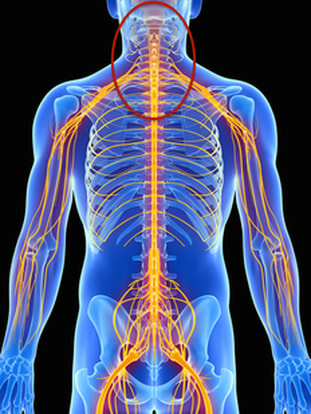Mechanical myelopathy of the cervical spine, what is it?

Cervical myelopathy is a pathological stenotic degeneration of the spine that leads to chronic irritation and progressive compression of the spinal cord and other neural tissues due to arthrosis, disc lesion and/or bone deformation. Osteophytes, disc protrusion or disc hernia, and degenerated ligaments all aggregate over time to irritate and eventually compress sensitive nerve tissue. The symptoms of this disease can vary and are not that easy to diagnose. Use of specific exams, such as a MRI or CAT scan and nerve conduction studies are necessary. With the MRI or CAT scan you can visualise spinal cord compromise and the extent of the pathology, nerve conduction studies quantify nerve compromise. Degeneration of the cervical spine is commonly found in the elderly (90% of subjects with at least 65 years of age) and more rare in the young (10% of those 25 years of age). However, the average incidence of this pathology falls around 45-50 years of age. At least 50% of the population of 50 years of age show signs of this progressive degeneration.
But before the progressive degeneration of the cervical spine reaches the point that causes compression of nerve tissues, there will be a chronic mechanical irritation due to loss of normal locomotor equilibrium. The first to suffer will be the dural sac, the spinal nerve roots and finally the spinal cord. The symptoms may be occasional and light, or frequent and heavy.
Common symptoms
Common symptoms of cervical myelopathy are pain localized in the area of the cervical spine which can also radiate to the shoulders, upper limbs or upper back. With chronic irritation of the dural sac headache is also possible. Another common phenomenon is a feeling of heaviness in the arms or weakness in the legs, as if they can no longer hold our weight properly. Some complain that their knee gives way while they are walking. Hands or feet may seem numb and there may be a notable decrease in grip strength, similar to a carpal tunnel syndrome. You may also have difficulty writing. Symptoms will not be the same for everyone, some will feel shock like sensations, as well as the tingling. Some may not feel the pain in the neck or lack of energy. In short, the big picture can vary according to the subject.
What do you do?
If there is degenerative compromise of sensory and motor function without grave physical pathology, manipulation has demonstrated to increase lost function and reduce symptoms. Combining treatment in the clinic, and proper self-management at home and at work, you can recover and live very well with this type of condition.
But before the progressive degeneration of the cervical spine reaches the point that causes compression of nerve tissues, there will be a chronic mechanical irritation due to loss of normal locomotor equilibrium. The first to suffer will be the dural sac, the spinal nerve roots and finally the spinal cord. The symptoms may be occasional and light, or frequent and heavy.
Common symptoms
Common symptoms of cervical myelopathy are pain localized in the area of the cervical spine which can also radiate to the shoulders, upper limbs or upper back. With chronic irritation of the dural sac headache is also possible. Another common phenomenon is a feeling of heaviness in the arms or weakness in the legs, as if they can no longer hold our weight properly. Some complain that their knee gives way while they are walking. Hands or feet may seem numb and there may be a notable decrease in grip strength, similar to a carpal tunnel syndrome. You may also have difficulty writing. Symptoms will not be the same for everyone, some will feel shock like sensations, as well as the tingling. Some may not feel the pain in the neck or lack of energy. In short, the big picture can vary according to the subject.
What do you do?
If there is degenerative compromise of sensory and motor function without grave physical pathology, manipulation has demonstrated to increase lost function and reduce symptoms. Combining treatment in the clinic, and proper self-management at home and at work, you can recover and live very well with this type of condition.
To better understand the nature of this pathology click here.